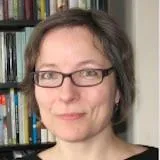In Bagdad there are twenty-eight Jewish Synagogues, situated either in the city itself or in Al-Karkh on the other side of the Tigris; for the river divides the metropolis into two parts. The great synagogue of the Exilarch has columns of marble of various colours overlaid with silver and gold, and on these columns are sentences of the Psalms in golden letters. And in front of the ark are about ten steps of marble; on the topmost step are the seats of the Exilarch and of the Princes of the House of David. The city of Bagdad is twenty miles in circumference, situated in a land of palms, gardens and plantations, the like of which is not to be found in the whole land of Shinar.’ (2)
03 December 2018
From the Tigris to the Thames
Andrea Schatz
Four rivers – Pishon, Gihon, Chiddeqel and Frat – left Gan Eden, Moses was found by Pharao’s daughter on the banks of the Nile, and the Israelites were able to cross over the Jordan on dry land.

Four rivers – Pishon, Gihon, Chiddeqel and Frat – left Gan Eden, Moses was found by Pharao’s daughter on the banks of the Nile, and the Israelites were able to cross over the Jordan on dry land. Ever since then, one might say, rivers have captured the Jewish imagination and connected Jewish communities across space and time. The Rhineland became the precarious home of some of the oldest communities in Ashkenaz. London’s medieval Jews have been called ‘river Jews’, as they moved to new places along the Thames. (1) And early modern Jews were fascinated by stories of the Sambatyon, a ‘sabbatical river’ that stopped flowing on the Shabbat. While rivers may change their course incessantly – or stop and resume their flow, they inscribe themselves permanently into the landscapes of history, memory, hopes and dreams.
On these pages, students and scholars working near the Thames and beyond share some of their discoveries. Continuity, flexibility, and the dialectical relationship between them are central to our inquiries. As we study and teach the Hebrew Bible, Second Temple Judaism, rabbinic literature, medieval Spain, early modern Ashkenaz and Jewish modernity in global contexts, we almost always encounter an author, a text, an issue – or a river – more than once. This is of particular interest to us: together, we explore Jewish texts and cultures within their historical settings and in their relation to present questions and debates.
The ‘Frat’ of Gan Eden was associated in later times with the Euphrates, one of ‘the rivers of Babylon’, where Jews were mourning the loss of Zion (Ps 137), and the ‘Chiddekel’ was associated with the Tigris, the river flowing through Baghdad. There, too, Jews lived in exile, but when Benjamin of Tudela wrote his medieval travelogue, he emphasised the marvels of the city and the splendour of its synagogues:
In our own time, the same river and the same city have found their way into another story of loss and hope. Sasson Somekh writes in his autobiography:
‘The serious problems that now afflict Iraq make it difficult to imagine a time in the near future when its various ethnic groups might again live together in harmony … So while it is, I realize, highly unlikely, I can at least indulge in the hope that one day I might visit Iraq and stroll again along the banks of the Tigris, the river of my childhood and early adolescence, and the site of my first efforts as a young Arab poet. Those banks have appeared in my dreams for many years.’ (3)
As we study the diversity of such sources and the many resonances between them – here as they reflect on exile and return – we often find that they speak to each other not just across space, but also across time.
In this sense, travels and travelling concepts are central to Jewish Studies – and to keeping this blog on the move.
(1) Jonathan Romain, ‘River Jews: Medieval Jews along the Thames as a Microcosm of Anglo-Jewry’, Jewish Historical Studies 43 (2011), 21-42.
(2) The Itinerary of Benjamin of Tudela, ed. Marcus Nathan Adler, London 1907.
(3) Sasson Somekh, Baghdad, Yesterday, Jerusalem 2007.
Image: Moses found among the reeds, Seder Haggadah shel Pessach, Amsterdam 1695. Copy of the National Library of Israel.

